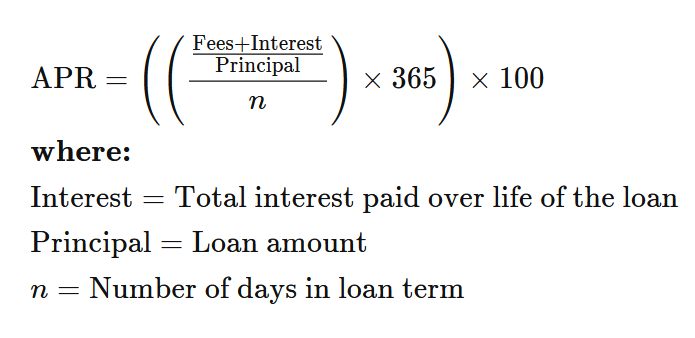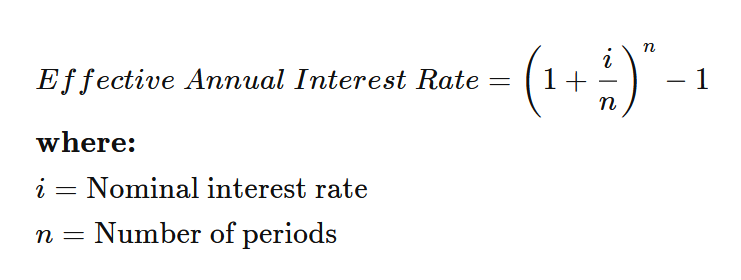Problem
How to calculate Effective Annual Interest Rate (EAR) and Annual Percentage Rate (APR) with fees (in R) ?
I am interested in getting to know how much I am actually paying interest when fees are taken into account and I assume EAR is the way to go, but correct me if I am wrong.
I tried to implement APR below as in the investopedia description but APR is lower than nominal interest so it is certainly not correct (should be around 3.5%)
What I have tried
Below an MVE which also explains the problem in more detail:
rm(list=ls())
library(reprex)
# define costs, fees and interests
price <- 24800
monthly_payment <- 280
deposit <- 4000
loan_term <- 5*12 #in months
initial_fee <- 300
monthly_fee <- 12
nominal_interest <- 2/100
monthly_interest <- nominal_interest/12
# initiate fixed costs, interest fees and total costs for the loop
handling_charges <- initial_fee
interest_fees <- 0
total_costs <- handling_charges
# substracting initial payment from the what is left variable
left <- price - deposit
#calculating how much of dept is left after loan period and how much interest has accumulated
for (i in 1:loan_term) {
left_last_month <- left
left <- left*(1+monthly_interest)
interest_fees_mo <- (left-left_last_month)
interest_fees <- interest_fees + interest_fees_mo
handling_charges <- handling_charges + monthly_fee
total_costs <- total_costs+ interest_fees_mo + monthly_fee
left <- left+monthly_fee-monthly_payment
}
#https://www.investopedia.com/terms/a/apr.asp
#https://www.investopedia.com/terms/e/effectiveinterest.asp
apr_100 <-
((
(total_costs/price)
/(loan_term*30.4375) # number of days in the loan term
)
*365.25) # number of days in a year
apr <- apr_100*100
# ear ???
share_of_loan_100 <- (total_costs/price)*100
share_of_loan_100
#> [1] 9.632864
left # after loan period ends
#> [1] 6088.95
interest_fees
#> [1] 1368.95
handling_charges
#> [1] 1020
total_costs
#> [1] 2388.95
apr # wrong
#> [1] 1.926573
# ear # ????
Created on 2022-01-20 by the reprex package (v2.0.1)
Definitions from investopedia:
APR
EAR, no fees taken into account
EDIT2:
Based on base64's suggestions, I think it is working now, albeit the code is ugly. Do you think it now give correct apr & apy ?
I added an option to either predifine monthly payment or calculate it based on the final payment (by setting monthly payment to FALSE, it will be approximated). There is also an option to choose when the interest compounds (eg. 1:12 for monthly, 1 for the first month of the year, c(6,12) for the 6th and 12th month of the year, since the beginning of the loan period).
After running the code, you can just plug in the values in the interest.F-function. See the two examples at the end (stack_example_monthly & stack_example_annual)
rm(list=ls())
library(reprex)
library(gtools)
# We need 3 helper functions
# 1. a precise enough binary search function
# 2. Payments function to calculate payments during the loan period
# 3. Apr to calculate the real interest rate
##########################################################
# 1. Binary search - helper function
##########################################################
# gtools binsearch-function modified for more accurate search results
# source: Gregory R. Warnes, Ben Bolker and Thomas Lumley (2021). gtools: Various R Programming Tools. R package version 3.9.2. https://CRAN.R-project.org/package=gtools
binsearch_decimal <- function(fun, range, ..., target = 0, lower = ceiling(min(range)),
upper = floor(max(range)), maxiter = 1000, showiter =FALSE)
{
lo <- lower
hi <- upper
counter <- 0
val.lo <- fun(lo, ...)
val.hi <- fun(hi, ...)
if (val.lo > val.hi) {
sign <- -1
}
else {
sign <- 1
}
if (target * sign < val.lo * sign) {
outside.range <- TRUE
}
else if (target * sign > val.hi * sign) {
outside.range <- TRUE
}
else {
outside.range <- FALSE
}
while (counter < maxiter && !outside.range) {
counter <- counter + 1
if (hi - lo <= 0.00001 || lo < lower || hi > upper) # 1 -> 0.00001
break
center <- round((hi - lo)/2 + lo, 6) # 0 -> 6
val <- fun(center, ...)
if (showiter) {
cat("--------------\n")
cat("Iteration #", counter, "\n")
cat("lo=", lo, "\n")
cat("hi=", hi, "\n")
cat("center=", center, "\n")
cat("fun(lo)=", val.lo, "\n")
cat("fun(hi)=", val.hi, "\n")
cat("fun(center)=", val, "\n")
}
if (val == target) {
val.lo <- val.hi <- val
lo <- hi <- center
break
}
else if (sign * val < sign * target) {
lo <- center
val.lo <- val
}
else {
hi <- center
val.hi <- val
}
if (showiter) {
cat("new lo=", lo, "\n")
cat("new hi=", hi, "\n")
cat("--------------\n")
}
}
retval <- list()
retval$call <- match.call()
retval$numiter <- counter
if (outside.range) {
if (target * sign < val.lo * sign) {
warning("Reached lower boundary")
retval$flag <- "Lower Boundary"
retval$where <- lo
retval$value <- val.lo
}
else {
warning("Reached upper boundary")
retval$flag <- "Upper Boundary"
retval$where <- hi
retval$value <- val.hi
}
}
else if (counter >= maxiter) {
warning("Maximum number of iterations reached")
retval$flag <- "Maximum number of iterations reached"
retval$where <- c(lo, hi)
retval$value <- c(val.lo, val.hi)
}
else if (val.lo == target) {
retval$flag <- "Found"
retval$where <- lo
retval$value <- val.lo
}
else if (val.hi == target) {
retval$flag <- "Found"
retval$where <- hi
retval$value <- val.hi
}
else {
retval$flag <- "Between Elements"
retval$where <- c(lo, hi)
retval$value <- c(val.lo, val.hi)
}
return(retval)
}
##############################################3
# 2.payments - helper function
##############################################
#calculating how much of dept is left after loan period and how much interest has accumulated
# includes an option to calculate monthly payment with binary search
payments.F <- function(monthly_payment, #
binary_search,
monthly_fee, #
nominal_interest,
price, #
deposit, #
initial_fee,
loan_term,
compounding) {#
# substracting initial payment and initial fees to get principal
principal <- price - deposit
left <- principal
# initiate parameters for the loop
handling_charges <- initial_fee
interest_fees <- 0
total_costs <- handling_charges
monthly_interest <- nominal_interest/12
month <- 1
no_of_compoundings <- length(compounding)
compounding_period_interest <- nominal_interest/length(compounding)
#defining a "not in" operator
`%!in%` <- Negate(`%in%`)
if ( (sum(compounding %in% 1:12) >0) & (sum(compounding %!in% 1:12) ==0) ) {
#print('--a valid compounding period set--')
} else {
stop("Error: Invalid compoumding value. Set it to a vector of months when you want it to compound, e.g. 1:12, c(6,12),5")
}
for (i in 1:loan_term) {
left_last_month <- left
if (month %in% compounding) {
left <-left*(1+compounding_period_interest)
}
interest_fees_mo <- (left-left_last_month)
interest_fees <- interest_fees + interest_fees_mo
handling_charges <- handling_charges + monthly_fee
total_costs <- total_costs+ interest_fees_mo + monthly_fee
left <- left+monthly_fee-monthly_payment
# incrementing or resetting monthly counter
month <- month+1
if (i %% 12 == 0) {
month <- 1
}
}
if (binary_search==T) {
return(left)
} else {
return(list("principal"=principal,
"left"=left,
"total_costs"=total_costs,
"interest_fees"=interest_fees,
"handling_charges"=handling_charges
))
}
}
############################################################################
# 3. APR - helper function
############################################################################
#apr will be later solved with binary search
apr.F <- function(APR,PMT,N,FV,PV) {
(PMT*((1-(1/(1+(APR/12))^N))/(APR/12)))+(FV/(1+(APR/12))^N)-(PV)
}
###########################################################################
# main function where we plug in the values
interest.F <- function(price,
loan_term=5*12,
initial_fee=0,
nominal_interest=2/100,
monthly_fee=12,
deposit=4000,
monthly_payment=F, # Set to false if you want to calculate monthly payment
final_payment=0, # If monthly payment is set, it will overrun this
compounding=1:12
) {
# running binary search to monthly cost if we have not defined it
if (monthly_payment==F) {
print('--Calculating monthly payment by binary search--')
(binsearch_monthly_payment <- binsearch_decimal(function(x)
payments.F(x, #
binary_search=T,
monthly_fee=monthly_fee, #
nominal_interest=nominal_interest,
price=price, #
deposit=deposit, #
initial_fee=initial_fee,
loan_term=loan_term,
compounding=compounding),
range = c(0,2000),
target=final_payment,
showiter = F))
monthly_payment <- mean(binsearch_monthly_payment$where)
} else {
print('--Using pre-fixed monthly payment amount--')
}
# assigning a payment scheme based on monthly payment (binary search or predefined)
(payments <- payments.F(monthly_payment,
binary_search = F,
monthly_fee=monthly_fee, #
nominal_interest=nominal_interest,
price=price, #
deposit=deposit, #
initial_fee=initial_fee,
loan_term=loan_term,
compounding=compounding))
paid_excluding_fees <- payments$principal-payments$left
# running a binary search to find apr given that we know how much we have repayed the loan (excluding fees)
(binsearch_apr <- binsearch_decimal(function(x)
apr.F(x,
PMT=monthly_payment,
N=loan_term,
FV=payments$left,
PV=payments$principal-initial_fee)
, range = c(-1,100),target=0))
#taking the mean value of the binary search to approximate apr
apr <- mean(binsearch_apr$where)
apr <- apr
#calculating apy based on apr
#https://www.investopedia.com/terms/a/apy.asp
apy <- (1+apr/12)^12-1
share_of_price <- (payments$total_costs/(price-initial_fee))*100
#payments$paid_excluding_fees <- paid_excluding_fees
payments$all_payments <- payments$total_costs + paid_excluding_fees +deposit
payments$monthly_payments <- monthly_payment
payments$share_of_price <- share_of_price
payments$apr <- apr*100
payments$apy <- apy*100
return(payments)
}
(stack_example_monthly <- interest.F(
price=24800,
loan_term=5*12,
initial_fee=300,
nominal_interest=2/100,
monthly_fee=12,
deposit=4000,
monthly_payment=F, # 280 # Set to false to estimate monthly payment
final_payment=6088.95, # 6088.95 If monthly payment is set, it will overrun this
compounding=1:12 # a vector, eg. 1:12, c(6,12), 5.
))
#> [1] "--Calculating monthly payment by binary search--"
#> $principal
#> [1] 20800
#>
#> $left
#> [1] 6088.95
#>
#> $total_costs
#> [1] 2388.95
#>
#> $interest_fees
#> [1] 1368.95
#>
#> $handling_charges
#> [1] 1020
#>
#> $all_payments
#> [1] 21100
#>
#> $monthly_payments
#> [1] 280
#>
#> $share_of_price
#> [1] 9.750817
#>
#> $apr
#> [1] 3.5069
#>
#> $apy
#> [1] 3.56382
(stack_example_annual <- interest.F(
price=24800,
loan_term=5*12,
initial_fee=300,
nominal_interest=2/100,
monthly_fee=12,
deposit=4000,
monthly_payment=280, # 280 # Set to false to estimate monthly payment
final_payment=NA, # 6088.95 If monthly payment is set, it will overrun this
compounding=12 # a vector, eg. 1:12, c(6,12), 5.
))
#> [1] "--Using pre-fixed monthly payment amount--"
#> $principal
#> [1] 20800
#>
#> $left
#> [1] 5921.857
#>
#> $total_costs
#> [1] 2221.857
#>
#> $interest_fees
#> [1] 1201.857
#>
#> $handling_charges
#> [1] 1020
#>
#> $all_payments
#> [1] 21100
#>
#> $monthly_payments
#> [1] 280
#>
#> $share_of_price
#> [1] 9.068805
#>
#> $apr
#> [1] 3.2841
#>
#> $apy
#> [1] 3.333986
Created on 2022-02-13 by the reprex package (v2.0.1)


